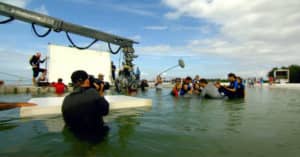Create
Vintage Pinellas: Making the ‘Dolphin Tale’ movies
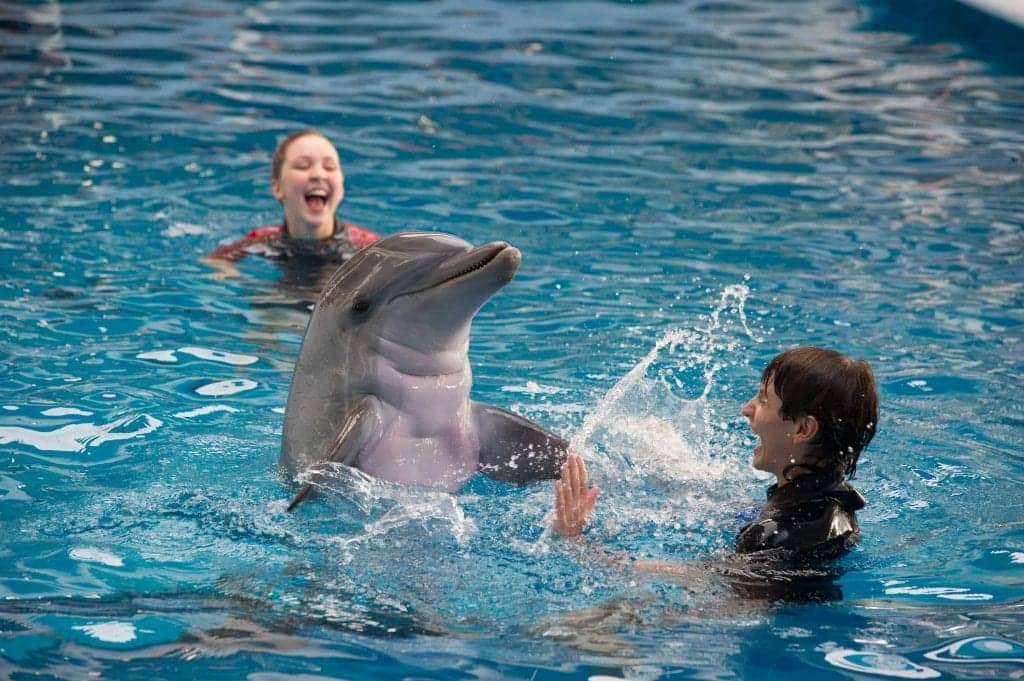
The story of Winter, the young bottlenose dolphin rescued on the east coast of Florida and brought back to life at the Clearwater Marine Aquarium, resonated around the world. After she lost her tail flukes from entanglement in a crab trap line, the animal was fitted with a custom-made prosthesis, and trained to swim with it.
Winter was saved by a dedicated team of marine biologists, scientists and volunteers.
And the Clearwater Marine Aquarium was itself saved by Winter. Before her arrival in December 2005, attendance at the somewhat ramshackle rescue and rehab center was around 76,000 annually.
Six years later, after the worldwide release of the family film Dolphin Tale, CMA was welcoming 800,000 visitors per year.
The benefits are still being felt, even after Winter’s tragic death from an intestinal ailment last November. The Clearwater Marine Aquarium, ramshackle no more, is a global tourist destination.
When David Yates signed on as the facility’s CEO in early 2006, he was brought over to the main rehab tank where Winter, barely four months old, was struggling to swim with a rotting tail, and was barely eating. “The whole industry said, she won’t survive,” Yates recalled. “We were advised to euthanize her.”
Indeed, the survival rate for stranded baby dolphins was low – if a marine mammal has beached, that’s almost always a sign of impending death.
Winter, however, hung on. And by the fall, Yates, who had run the Ironman Triathlon organization for 11 years and had produced numerous TV specials (winning three Sports Emmys in the process), saw a marketing opportunity.
“The Ironman brand is very like the Winter brand,” he explained. “It’s about courage, perseverance, never giving up. I thought ‘I’ve got the same story here that I had 10 years ago – I’m going to pitch this the same way.’”
He chronicled her rehabilitation by CMA veterinarians and staff in a series of video mini-documentaries. Over time, these came to include prosthetist Kevin Carroll’s introduction of a plastic-and-rubber tail that fit snugly over the dolphin’s tail stump.
Yates and CMA dolphin handlers appeared on national TV. Winter’s story was picked up by the news wires.
In 2009, Scholastic Press published Winter’s Tail: How One Little Dolphin Learned to Swim Again, a book for young readers.
The book caught the eye of Los Angeles-based Alcon Entertainment, producers of The Blind Side, Sisterhood of the Traveling Pants and Dude, Where’s My Car?
From the start, all involved agreed the movie would balance “feel-good” with the serious part of the story, keeping the science – along with the selfless volunteer spirit – front and center.
Dolphins in captivity at CMA are there because they can’t be released back into the wild, for medical reasons. They are not there to perform “tricks” on command.
“And it had to be filmed here, because Winter was here,” Yates recalled. “We couldn’t stop our animal care work.
“And we’re not going to have Winter do stuff she can’t do. We’re not going to stress her out.
“So a lot of planning went into it: Here’s what Winter does; how can we work these into the film?
“We realized that to film properly, we couldn’t allow our guests to come in. And attendance wasn’t near what it is now. We closed down for 65 days, give or take, and Alcon paid our lost revenue.
“But it was a challenge. We had to tell the hotels, don’t send people.”
“There was never any question that we’d use the real dolphin,” executive producer Robert Engleman explained in the Orlando Sentinel. “Winter has this incredible personality, and she’s unique. Not having a tail, she moves differently from other dolphins. You can’t fake that. No other dolphin could be her double.”
 Karen Jantzen and Noam Dromi wrote the script for Dolphin Tale, wrapping the core of Winter’s story into a tidy tale about a shy young boy who bonds with the injured dolphin in her CMA tank, and becomes a key member of Winter’s human “family.”
Karen Jantzen and Noam Dromi wrote the script for Dolphin Tale, wrapping the core of Winter’s story into a tidy tale about a shy young boy who bonds with the injured dolphin in her CMA tank, and becomes a key member of Winter’s human “family.”
Production began in September, 2010, with actor Charles Martin Smith (American Graffiti, Never Cry Wolf, The Untouchables) in the director’s chair.
Smith, whose work as director included the well-received family film Air Bud, said of Dolphin Tale: “I think people talk down to kids too much. I think kids’ movies can be great and carry the weight and pathos of an adult drama. They tend to get short shrift, but the kids are smarter than we give them credit for.”
 Yates was a co-producer on the film, which was shot in 3D. This required particularly large cameras – one reason Alcon built an additional 80,000-gallon tank for Winter on the CMA site. The cameras – and the now 4-year-old dolphin, who’d be “playing” herself – would have plenty of room in which to maneuver.
Yates was a co-producer on the film, which was shot in 3D. This required particularly large cameras – one reason Alcon built an additional 80,000-gallon tank for Winter on the CMA site. The cameras – and the now 4-year-old dolphin, who’d be “playing” herself – would have plenty of room in which to maneuver.
Characters were combined, eliminated and created from whole cloth to streamline the story that Alcon, Smith and company wanted to tell. Harry Connick Jr. was cast as biologist Clay Haskett, operator of the CMA and Winter’s chief caretaker. Morgan Freeman took the role of Dr. Cameron McCarthy, designer of the prosthetic tail. Kris Kristofferson signed on to play Clay’s father, and the central role of fictional Sawyer Nelson was played by 12-year-old Seattle actor Nathan Gamble (with Ashley Judd as his widowed mother).
Now 24, Gamble looks back on his Dolphin Tale experience with pride. Still, he recalled, after he was offered the part, there was still a matter of chemistry with his aquatic co-star: Would there be any?
Thus, the litmus test.
“Let’s be real: Morgan Freeman is not the star, Harry Connick’s not the star … I’m not even the star,” Gamble said. “Winter the dolphin is the star. And if Winter the dolphin doesn’t like Nathan Gamble, who’s going to be Sawyer, then Nathan Gamble’s not going to be Sawyer.”
 Alcon flew him to Florida. “They had me hang out with her for a couple days. I was terrified out of my mind. I was 12 years old and I had never seen a dolphin, let alone swam with the most famous dolphin of all time. It was nerve-wracking at first, for sure.”
Alcon flew him to Florida. “They had me hang out with her for a couple days. I was terrified out of my mind. I was 12 years old and I had never seen a dolphin, let alone swam with the most famous dolphin of all time. It was nerve-wracking at first, for sure.”
In time, though, all was going swimmingly. “The more time you spend with a person, the more you get to know them,” Gamble said. “What they like and what they don’t like. It was the same with Winter.
“There were certain things, movements that I would do with her that she really responded well to – and there were certain movements that maybe she didn’t like. So I just wouldn’t do that.”
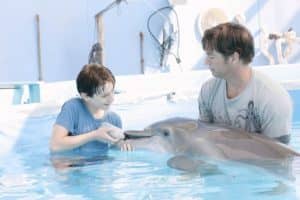
Nathan Gamble, left, and Harry Connick Jr.
It didn’t hurt, he confessed, that he always had a bucket of fish handy. “But when it comes to that connection, it built up over time. It was treating Winter not like an animal, but like another actor who has their own personality, in a sense.”
Principal photography on Dolphin Tale lasted 60 days. Some days, Yates said, Winter, or one of the other dolphins, simply refused to cooperate. Rather than force the issue, which would only stress the animals, the filmmakers would use the time to film another scene, using only the human actors. “We did things on her schedule,” according to Yates.
“Dolphins are very intelligent animals. We do a thing called enrichment. All the dolphins had very planned days. We had to keep them mentally engaged. Otherwise, they could get sick and die.
“So we made the movie enrichment. And if Winter just didn’t want to do something, we’d do something else.”
Although there is computer-generated imagery (CGI) in Dolphin Tale, it’s used sparingly. Similarly, animatronics and lifelike puppets were utilized on occasion (many of Winter’s out-of-water closeups, for example, aren’t really her).
Nearly all of the water scenes, according to Gamble, feature the real Winter.
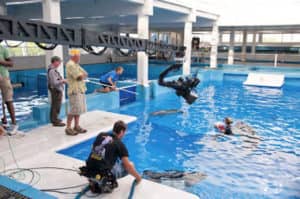 Her handlers worked for months acclimating the dolphin to the mechanics of movie-making. “In order to shoot over water, you’ve got to have a giant crane with the giant camera attached to the end,” Gamble explained. “It hovers around the pool. In order to acclimate Winter, they had a foam thing that looked exactly like the crane. And also, they would have random people in the water, holding giant camera-like things, to just get her used to it.
Her handlers worked for months acclimating the dolphin to the mechanics of movie-making. “In order to shoot over water, you’ve got to have a giant crane with the giant camera attached to the end,” Gamble explained. “It hovers around the pool. In order to acclimate Winter, they had a foam thing that looked exactly like the crane. And also, they would have random people in the water, holding giant camera-like things, to just get her used to it.
“Because we never wanted to startle her, and never wanted to force her to do anything she did not want to do.”
The company shot additional scenes at Clearwater’s Long Center pool, Admiral Farragut Academy, the back yard of a private home on Betty Lane in Clearwater, Satinleaf Avenue in Oldsmar, and on a stretch of Honeymoon Island beach, where Gamble-as-Sawyer happens upon (animatronic) baby Winter tangled in nylon ropes.
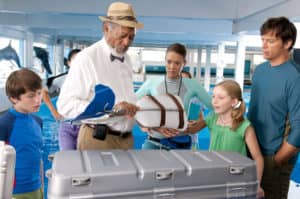
Gamble, left, Morgan Freeman, Austin Highsmith, Zuehlsdorff, Connick.
Released in 2011, Dolphin Tale attracted mostly glowing reviews. “The best family film to come along in a decade,” raved the Dallas Morning News. At the box office, it nearly tripled its $37 million budget.
Winter’s effect on children around the world was profound. Sure, the thousands who flocked to CMA after Dolphin Tale (and its 2014 sequel) came, for the most part, to spend a few minutes with the resilient star of their favorite animal movie.
More than that, however, Winter became a role model for kids with disabilities. “The weekend Dolphin Tale came out, from Friday noon to Sunday night, we got 10,000 emails,” Yates said. “Just two and a half days.
“The vast majority were from moms saying ‘I want to tell you how Winter changed my child’s life.’ These are Make-a-Wish kids. These are kids in hospital beds in England, having brain tumors and going into surgery.”
The letters, emails and video messages poured in: “If Winter can do it, I can do it.”

Winter and Hope.
Late in the afternoon of Dec. 11, 2010, the final day of principal photography, Yates was at home getting ready for the evening’s wrap party at Island Way Grill, next door to the Clearwater Marine Aquarium. Cast and crew would gather to celebrate the ending of filming, then go their separate ways.
He received a call from the CMA rescue team. They were heading back to the east coast, in the same general area where Winter had been discovered. Another baby dolphin had beached in distress. That very day.
This became the talk of the wrap party, and as Yates and members of the CMA staff left to meet the arriving truck around midnight, cast and crew began to migrate over, too.
When the new dolphin, who would be nicknamed Hope, arrived, a CMA veterinarian took her from the back of the truck and carried up the stairs leading to the rehab pool, rather than waiting for the crane normally used for such work.
This would become a scene in Dolphin Tale 2, shot – with all the major cast members returning – in 2013 (Connick’s character carried little Hope up the stairs).
Director Smith, who wrote the script, made Hope the star of the sequel. In the story, Winter has sunk into depression following the (natural) death of her 40-year-old tankmate.
Hope arrives, a new bond is formed, and there are smiles all around.
“The first one was such a beautiful package, a great story with a beginning, a middle and an end,” Connick told St. Petersburg Times writer Steve Persall. “Then I read the second script and was absolutely blown away. There’s no wonder why every single person in the cast showed up to do it again.”
With visitation at an all-time high because of the worldwide success of the first film, it was decided that closing CMA for two full months – to produce Dolphin Tale 2 – wouldn’t be advisable. So a compromise was reached – Alcon had the run of the place on weekdays, but the facility would open for visitors on Saturday and Sundays, with no Hollywood types in sight.
Other locations included Fort De Soto Park, Morgan Stanley Tower, Florida Hospital North Pinellas and the sponge docks (both in Tarpon Springs). Island Way Grill was used for a party scene.
The movie took in $57.8 million, significantly less than its predecessor but more than enough to recoup its costs.
According to the Clearwater Marine Aquarium, the two films combined resulted in a $2 billion impact to Pinellas County. In 2020, CMA opened an $80 million expansion, including a new 1.5 million gallon water habitat.
“There’s no place in the world you’ll find that impacted more kids in the way that CMA did, because of the movies,” Yates beamed.
Yates, who left CMA in 2020, has begin producing films in and around Pinellas County, and will publish a memoir, Swimming Upstream: My Journey from Adversity to Hope and Inspiration and a BIG LIFE with Winter the Dolphin, in May.
He knows he was part of something incredibly special. “Winter’s legacy is about CMA and its mission,” Yates said. “And it’s about changing the lives of kids, which will never go away.”
Gamble, who frequently visits the bay area, is humbled to be recognized on the street, more than a decade later, as the young boy who bonded with Winter in those movies.
“I know that most actors would love to say that they were a part of it,” he said. “Even if I have only a small percentage of what it was, I’m very blessed to say that I was a part of something like that.”
This story appears in the book Vintage St . Pete & Vintage Pinellas Volume 3.
